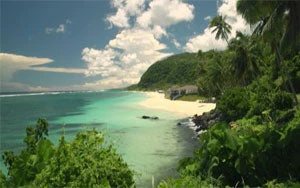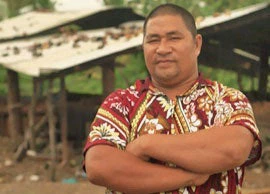
A few months later, the country was once again centre stage. This time for something utterly distressing and heart-breaking as the country embarked on the harrowing search for real life survivors after they were struck by a powerful tsunami on 29 September 2009.
Galu afi means “wave of fire” and is the traditional Samoan word used to describe a tsunami. It describes the force that gains momentum as the wave generates and the sheer destruction that it brings to bear. That is what happened here.
143 people lost their lives that day, many of whom were children on their way to school. The tsunami decimated the villages, plucked trees from the earth and literally sucked sand off the beaches leaving them bare. It took homes, cars and boats. Where it touched little remained. For many all it left was an unshakeable fear. A fear of what the ocean can do.
And it was this fear that drove many villagers to rebuild on higher ground rather than seaside where many had lived for generations. Two years later – a new village built on higher ground has been created – named Saleapaga 2 after its namesake that was destroyed.
The World Bank contributed to the development of this new community, by supporting new roads (with additional support from PRIF & AusAID) which were used to draw together schools, hospital and homes; provided budget support which was used by the government to provide grants to families to rebuild their homes; and financed post tsunami health sector needs, like the financing of doctors to help support local efforts.
I recently visited Samoa and visited the sites worst hit by the tsunami and the new Saleapaga village. I spoke to people about their experiences then and now. Here are their stories:
The Grandmother
 |
| Fa’atamali relocated to a village on higher ground. |
Fa’atamali led us into a brightly coloured room, decorated with toys and photos of the children and grandchildren she lost. In the centre of her home is a bookcase that displays toys she was given in the aftermath of the tsunami. She clutched a bible as she spoke.
On the day of the tsunami, she didn’t have time to get away. “I heard a big roar behind us and I turned around and it was the big wave. It was the last time I saw the wave because I just turned around and ran for my life. I ran to the other side of our house. I arrived on the first step and the wave hit me. That was the last thing I knew. I was just floating together with the debris from the house.”
She found herself sucked far out in the ocean lagoon, floating with debris. She was terrified by the deepness, darkness and the presence of sharks. When she came ashore her husband found her, held her head and told her he was so glad she was alive because he was worried she was the family’s seventh loss.
“I was told that my kids were dead and I was so sad because of what happened. I was crying. I wish I died with them. Because there were so many of my kids that passed away and died. That is what happened to me that day.”
She found the thought of living by the ocean impossible and moved up to the new relocated village on higher ground. Here, she explained, they all feel better. They received a government grant and were able to start building a new house. She explains the new road has really helped connect them but the thing that makes her feel most comfortable is that their home is where they can no longer hear the ocean.
For her–she won’t ever get over the grief. It is impossible. But life has been made easier.
The kid called Tsunami
I visited some other houses that were built using the government grants. At one place in particular there were about six boys playing, they were all pretty tough. Some of them had been swept up in the tsunami and survived, and they reflected this fearlessness borne from experience. Amongst the brood though was a little one and whenever I came near him he started screaming, hysterically. He was such an outlier to the pack that I eventually asked the other kids his name in an effort to win him over. “Tsunami,” they said.
“What?”
‘Tsunami”, they repeated.
Born two days after the tsunami – the family had named their child after the most monumental event they will probably experience in their lives.
He lives in the new village and luckily did not have to experience that day. But forever more he will be a living testimony for those around him. For him, he has been able to fit straight into a new life – with roads, schools, hospital access – with the primary memory of that fateful day is his name.
The business owner
 |
| Samasoni has relocated and rebuilt his home and business. |
Samasoni has rebuilt his copra business from scratch.
“When the tsunami hit all the copra and coconut at the business was taken away - we didn’t really care but we thanked god that we lived and survived the tsunami,” he said.
He has relocated to the resettled community. Not only has he been able to rebuild his business and home but has managed to make it his small copra business the number one copra supplier on the island. He employs a lot of people in the new village.
“When the people from the village sell me coconut they get money for their family and also for school fees for their children,” he said.
Integral to the re- establishment of his business was the road.
“The most pressing problem we faced in starting the business again in this new location was the condition of the road and no capital to start up the business again. So that’s why we were looking for help ,” he said. “The road to our present location has played a vital part in establishing our business and making life easier for us in this new location.”
See their stories and more here:
[[avp asset="/content/dam/videos/eap/2018/jun/restoring_paradise_after_the_2009_tsunami_in_samoa_hd.flv"]]/content/dam/videos/eap/2018/jun/restoring_paradise_after_the_2009_tsunami_in_samoa_hd.flv[[/avp]]


Join the Conversation